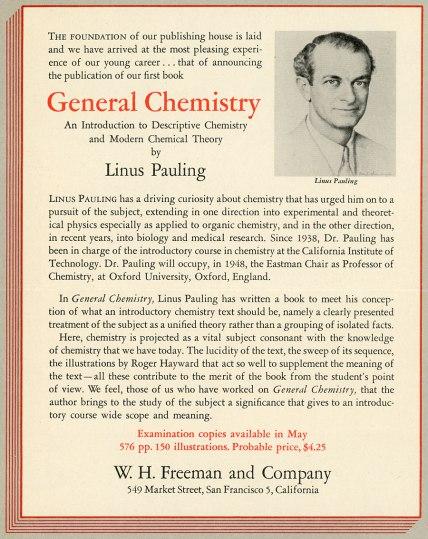
[An examination of General Chemistry, published by Linus Pauling seventy years ago. This is part 2 of 7.]
William Hazen “Bill” Freeman established the publishing firm of W.H. Freeman and Company in 1946. On breaking with his previous employer MacMillan Publishers, Freeman said simply, “We made so bold a move because we found that every factor contributing to the success of such a venture was at hand, waiting to be put to work.” There is little doubt that Freeman was thinking of Linus Pauling when he made this statement, but his confidence was also born of extensive experience in the publishing world, working especially with college textbooks.
Freeman brought all his resources and skills to bear on Pauling’s General Chemistry manuscript. He began by circulating early drafts of the text to curate specific feedback in cases where he himself was not equipped to offer it. He also promoted the finished text tirelessly and, through the process, worked without complaint around Pauling’s complicated lecture and travel schedule. Put simply, Freeman knew that he had a singular resource in hand with Linus Pauling, and he did his best to do right by this relationship, both out of respect for Pauling and out of interest in building his business.
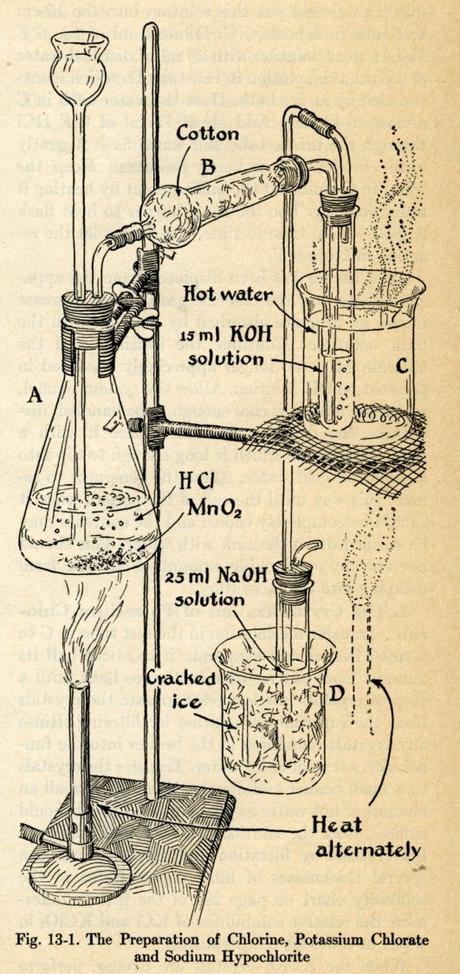
Illustration prepared by Roger Hayward for use in General Chemistry, 1947.
Without question, another individual who contributed greatly to the success of General Chemistry – and to W.H. Freeman and Company – was Roger Hayward, who joined the duo early on as an illustrator at Pauling’s insistence. Hayward moved from the East Coast to Pasadena in 1929, upon which time he became a member of the Caltech One-Hundred-to-One Shot Club, which was comprised of individuals interested in astronomy. Through this connection, Hayward gradually came to be involved with several projects involving Caltech faculty and ultimately met Pauling in the 1930s.
Hayward was an architect by training and Pauling so respected his skill as a draftsman and an artist that he insisted that he was the only one up to the task of creating illustrations for General Chemistry. Pauling was no doubt attracted to Hayward’s unique approach to scientific illustration, wherein he conducted in-depth and detailed research on the scientific principles underlying his topic before ever setting pencil to paper. Freeman also recognized Hayward’s unrivaled skill, and enlisted him on a number of other projects beyond Pauling’s text. By the end of their partnership, Pauling considered Hayward to be not only a collaborator and a friend, but a scientist as well.
As the General Chemistry text was being developed, Pauling evinced such faith in Hayward’s abilities that he offered to transfer .05% of his royalty rate to the illustrator, a payment that would be made in addition to the fee that Freeman and Co. had contracted for the illustrations themselves. Bill Freeman agreed to this arrangement and generously matched Pauling’s offer such that Hayward ultimately received royalties at the rate of 1% for every copy sold – a rate nearly as high as Pauling’s 1.5% royalty agreement.
While seemingly generous, this understanding later proved to be fraught with complications, and Hayward often complained that Freeman and Co. did not adequately compensate him for the amount and quality of work that he contributed. Pauling and Freeman, growing exasperated with this behavior, privately agreed that Hayward was a key contributer but also a “bit of a prima donna.”
Nonetheless, Freeman deeply respected Hayward as a serious artist and clearly understood the value that he brought to the company. As a result, he strove to adjust financial arrangements so that they would benefit all parties involved. For a brief period in the early 1950s, Freeman even brought Hayward on under contract as a staffmember at Freeman and Co. Although the arrangement ended before Hayward’s ten-year deal had expired, the two men deeply appreciated the friendship they shared. Indeed, even in the midst of sensitive and difficult financial negotiations, their letters often ended with mutual expressions of hope that they would see one other soon.
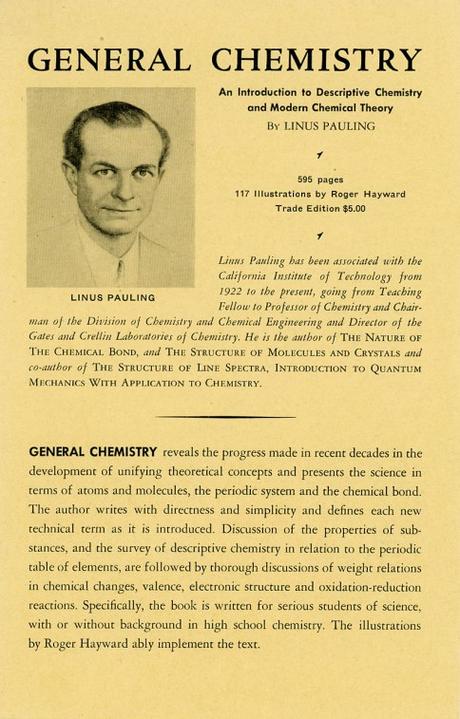
Under Freeman’s stewardship, Pauling’s manuscript underwent a number of important changes. Initially organized into thirteen chapters, the text was ultimately divided into thirty-three chapters by the time of its publication. In so doing, Freeman and Pauling agreed to remove an initial chapter on valence, choosing instead to disburse the subject matter into a series of subsections located throughout the book.
Likewise, in the manuscript version, Pauling had included a small introductory paragraph on the broader subject of chemistry before diving into his material. In the published book, Pauling instead dedicated his entire first chapter to the importance of studying chemistry as well as the mission and philosophy of the textbook that he had written to help aid in this endeavor. This change allowed Pauling to provide guidance to students on how they might use the book itself, a particularly important addition given that he was breaking from traditional pedagogical styles.
Freeman and Pauling also decided to move chapters on chemical reactions, the properties of gases, and thermochemistry to the end of the book, judging these topics to be sufficiently advanced that a strong foundation on elementary topics should be established first.
Most of the changes that Pauling and Freeman made reflected a desire to create more space to explore topics and to build logical connections between sections and chapters. In the chapters that Pauling eventually added, he covered specific elements like sulfur and nitrogen, as well as compounds including water and several metals. Other changes in chapter order enabled deeper introductions to substances and solutions prior to walking readers through investigations of matter, properties, and variations.
As late as 1947, mere months before Freeman and Co. released the book, Pauling was still calling his text Principles of Chemistry. Freeman suggested that the title be changed to A General Chemistry, because he felt that it conveyed a sense of modesty.
Once Pauling had dropped the indefinite article in favor of a more authoritative title, General Chemistry, Freeman offered him three possible subtitles from which to choose: “An Introduction to Modern Theory and Descriptive Chemistry,” “A Statement of Modern Theory and Descriptive Chemistry,” or “An Introductory Statement of Modern Theory and Descriptive Chemistry.” Pauling eventually synthesized the three into “An Introduction to Descriptive Chemistry and Modern Chemical Theory.”
This subtitle reflected Pauling’s goal for the book itself: in his text, he sought to present descriptive chemistry and theoretical chemistry alongside one another to illustrate their equal significance and impact. His first chapter made clear that he felt practical work, in tandem with study and review of the facts of chemistry, were vital to a full understanding of the subject. In reflecting on this point, he noted that
A well-educated man or woman needs to have an understanding of the material world in which he lives as well as of literature and history, and he may find great pleasure in the appreciation of new knowledge as it results from scientific progress.
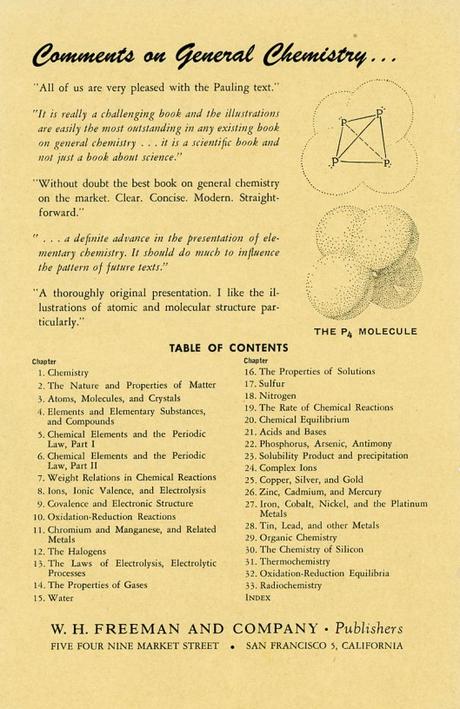
Once Pauling had a completed his draft, he and Freeman fell into a rhythm, editing the manuscript collaboratively through a series of memos and letters. Pauling typically submitted one chapter at a time, to which Freeman would quickly reply with corrections and suggestions. From there, Pauling would counter by accepting, rejecting, or offering alternate suggestions. In effect, the letters acted as a written dialog between the two; Freeman providing detailed explanations with his feedback and Pauling taking care to respond and explain his choices.
By February 1947, Freeman told Pauling that their collaboration had exceeded his initial expectations for progress, but that they still needed to keep pushing if they hoped to have a successful first year. The publisher’s goal was to sell between 13,000 to 16,000 copies of the book within its first year in circulation, but this number would only be attainable if they had shipped review copies to professors before the end of spring term.
Subsequently, the two increased the pace of their correspondence and managed to get 500 review copies out by the end of May 1947, with an official release date set for that September. The estimated price of the volume was $4.25 per copy. It would span 600 pages and include 160 of Hayward’s illustrations. Just prior to printing, Pauling wrote a preface that stated his goal for the text:
a special effort has been made in this book to present the subject of chemistry in a logical and simple matter, and to correlate descriptive chemistry with the theories of chemistry.
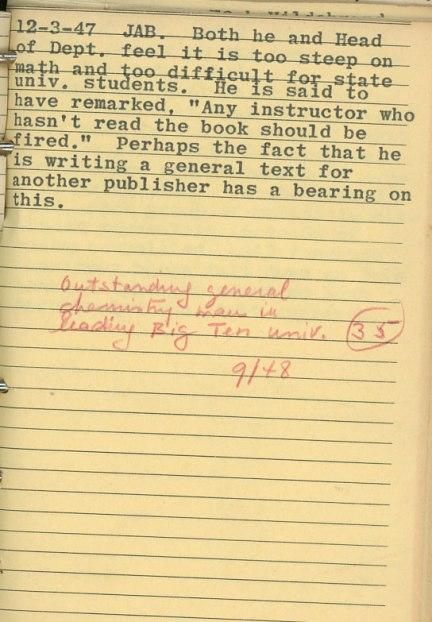
Comment sheet collected by Bill Freeman, 1947.
As they neared completion, Pauling offered to assist with his own marketing by proposing that he send a table of contents and brief description of the book to former Ph.D. students from Caltech who were now teaching classes of their own. Freeman gently declined this idea, explaining to Pauling that an author did not conventionally promote his own text and asking that all marketing activities be left to the publishing house. Freeman and his assistant, Janet MacRorie, subsequently created a vigorous advertising plan, targeting chemistry professors at all major universities as well as several smaller institutions. The publishers also sent out an open later including excerpts from the book that Freeman believed best demonstrated Pauling’s distinct and straightforward writing style.
In April, Freeman and Co. sent page proofs of the first five chapters of the book to fifteen different schools, with the idea that doing so would allow them to receive and incorporate feedback in the finished product. The response was overwhelmingly positive, but did contain points of constructive criticism that provided direction for revision. Reviewers typically highlighted passages that they felt would be too complex or confusing for their own classes, drawing from their own unique experiences working with undergraduates.
Freeman collected the primary concerns expressed about the book and organized them for Pauling to review. Though some felt that the text was too challenging, Freeman remained confident that even those who were critical in the beginning would return to it if Pauling spent the next year collecting observations and announcing plans for revision at a forthcoming date.
Pauling and Freeman were both deeply invested in the project, so much so that, when it came out, Freeman told Pauling that he felt like a “first time father in the maternity ward.” Once the final version arrived back from the printers, it became clear that Freeman’s commitment to meticulous editing had paid off; Pauling remarked that he had never seen such an extensive publication that contained so few errors.
The duo soon had further reason to celebrate: by June 1948, over forty colleges had adopted or were planning to adopt General Chemistry. Meanwhile, Pauling’s royalties for the first printing of the book summed to nearly $3,700 (over $38,000 in today’s dollars) and continued to increase over the next ten years, bumping up significantly more after the release of the second edition. By the end of 1950, eighty-three colleges had adopted General Chemistry and Pauling’s royalty rate had increased from 1.5% to 3%. For author and publisher both, this project was already a huge success.
Advertisements